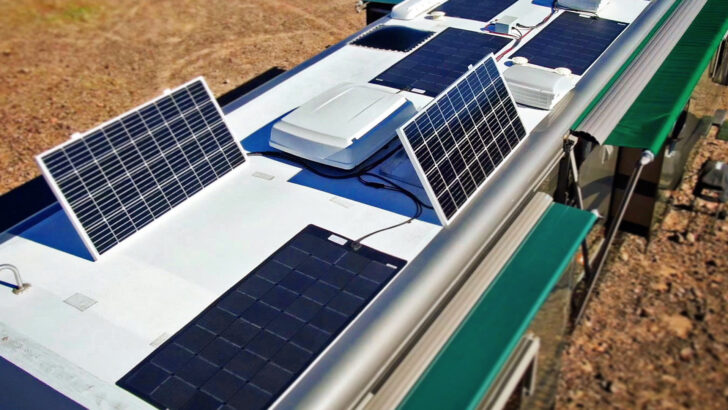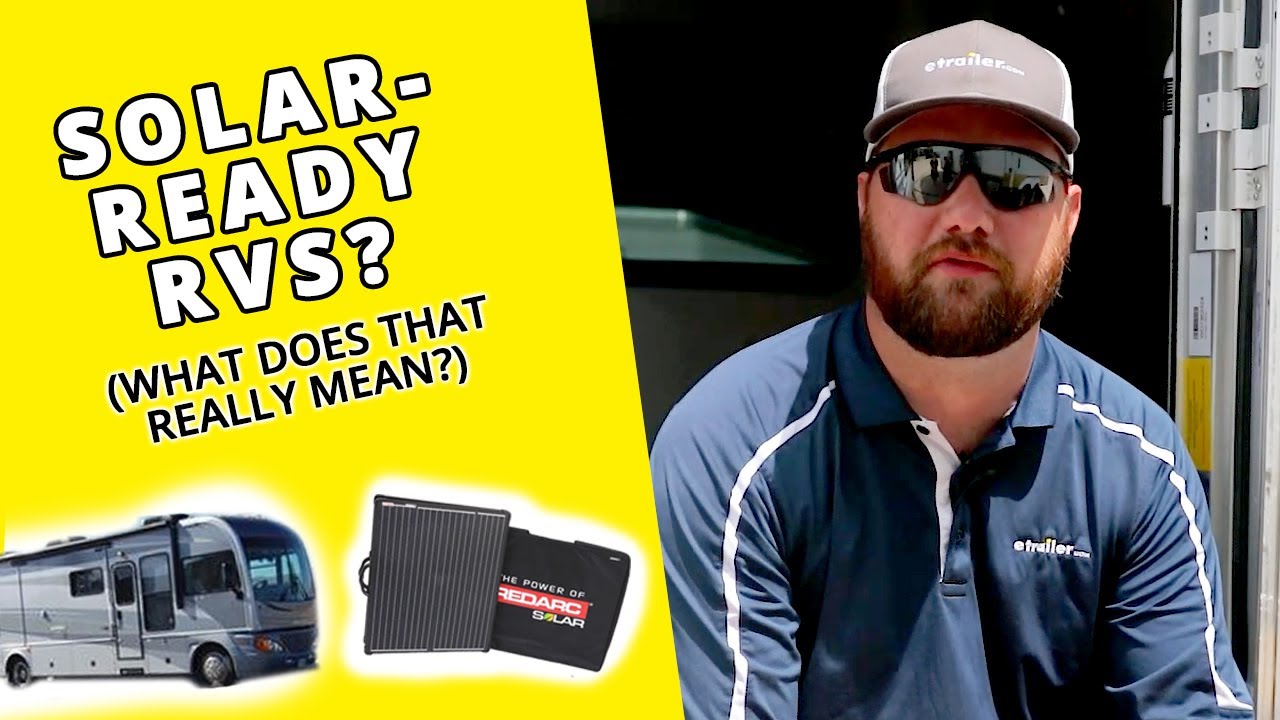When an RV is solar ready, it means that the RV is equipped with the necessary wiring and mounting hardware to connect solar panels. Solar power can provide a significant source of energy for RVs, allowing them to run more appliances and devices while dry camping or boondocking. Many newer RVs come pre-wired for solar, making it easy to add panels at a later date.
If you’re considering adding solar panels to your RV, you may be wondering what “solar ready” means. Solar ready RVs have a few key features that make them ideal for solar installation. First, they typically have a large, flat roof that’s uncluttered and free of obstructions.
This gives you plenty of space to mount the panels. Second, they often have pre-wired electrical connections that make it easy to connect the panels to your RV’s electrical system. Finally, solar ready RVs tend to have high-quality insulation that helps keep the heat in during winter and out during summer – both of which are critical for maximizing solar power output.
So if you’re thinking about going solar, look for an RV that’s solar ready!

Credit: www.thervgeeks.com
What Does It Mean to Be Solar Ready?
If you’re considering going solar, one of the first things you need to do is make sure your home is “solar ready.” Solar readiness means that your home is able to support a solar energy system and that you’ve taken the necessary steps to prepare for installation.
There are a few different things that go into making a home solar ready.
First, your roof needs to be in good condition and able to support the weight of the solar panels. If you have an older home, it’s a good idea to have a structural engineer assess your roof before moving forward with solar.
Second, you’ll need to determine if there are any shading issues on your property that could affect the performance of your solar panels.
Trees, buildings, and other structures can all create shading problems. An experienced solar installer will be able to help you identify any potential shading issues and find solutions.
Third, you’ll need to make sure your electrical system is up to code and can handle the additional power that will be generated by your solar panels.
This usually involves upgrading your electrical panel and having a new circuit breaker installed. Again, an experienced solar installer will be able to handle this for you.
Taking these steps ahead of time will help ensure that your transition to solar goes smoothly and that you get the most out of your investment.
How Do You Hook Up Solar Panels to a Solar Ready Rv?
Assuming you have a solar ready RV, it should come with a pre-installed solar port. If not, you will need to install one. You will also need to purchase solar panels and an inverter.
Once you have all of your equipment, follow these instructions:
1. Park your RV in a sunny location.
2. Connect the positive lead from the solar panel to the positive terminal on the inverter, then do the same for the negative leads.
3. Plug the inverter into a standard 120-volt AC outlet or connect it directly to your RV’s battery using battery clamps.
4. Turn on the switch on the inverter (it may be located inside your RV). This will convert DC power from the solar panels into AC power that can be used to run appliances and charge batteries.
What Do I Need If My Trailer is Solar Ready?
If you’re looking to go solar on your RV or trailer, there are a few things you’ll need to consider. First, you’ll need to determine if your RV or trailer is “solar ready.” This means that it has the necessary plumbing and wiring in place to support a solar system.
If it’s not solar ready, you may be able to have it retrofitted by a qualified installer.
Once you’ve determined that your RV or trailer is solar ready, you’ll need to decide what type of solar system you want. There are two main types of solar systems for RVs and trailers: portable and permanently mounted.
Portable systems are less expensive and easier to install, but they must be removed and stored when not in use. Permanently mounted systems are more expensive but they’re also more durable and convenient since they’re always in place.
Finally, you’ll need to gather the necessary equipment for your chosen solar system.
This includes solar panels, batteries, charge controllers, wiring, and mounts (if needed). Once you have all the equipment, follow the instructions provided by the manufacturer to install your system.
What Does a Solar Ready Panel Mean?
A solar ready panel is a specially designed electrical panel that is intended to be used in conjunction with solar power systems. The panel includes features such as dedicated circuit breakers and wiring that make it safe and easy to connect solar panels to the rest of your home’s electrical system. Solar ready panels are an important part of any solar power installation, and they can help you get the most out of your solar panels by making sure that they are properly integrated into your home’s electrical system.
Is My RV Really “Solar Ready?” (What Does That Mean!?)
Forest River Rv Solar Ready
Forest River RV Solar Ready is a program that allows customers to install solar panels on their RVs. The program includes all of the necessary components and wiring to connect the solar panel to the RV’s electrical system.Solar power is a great way to reduce your carbon footprint and save money on your electric bill. With Forest River RV Solar Ready, you can do both!
Keystone Rv Solar Ready
Keystone RV Solar Ready is an exciting new technology that allows you to harness the power of the sun to provide energy for your RV. This system uses a solar panel to collect energy from the sun and then converts it into electrical power that can be used to run appliances, lights, and other devices in your RV. The best part about this system is that it is completely portable, so you can take it with you wherever you go.
Jayco Solar Ready
As the world progresses, so does technology. And with technology becoming more advanced, solar power is becoming more and more popular as a means to power homes and businesses. Jayco is one company that has taken notice of this trend and has created a line of solar ready products to make going solar easier than ever before.
Solar Ready products are designed to be easily integrated with existing Jayco products or can be used as stand-alone systems. Either way, Solar Ready products provide a great way to get started with solar power without having to make any major changes or investments.
One of the most popular Solar Ready products is the Jayco Solar Ready Inverter.
This inverter allows you to store energy from your solar panels in batteries so that you can use it even when the sun isn’t shining. It’s a great way to make sure you always have power, even if the weather isn’t cooperating.
If you’re interested in learning more about Jayco Solar Ready products or want to see what other options are available, head over to their website today.
With their help, making the switch to solar power has never been easier!
How Does the Solar Plug on My Rv Work
The solar plug on an RV is a great way to get power while out on the road. Here’s how it works:
There are two main types of solar plugs – those that work with an adapter, and those that don’t.
If your RV has a built-in solar panel, then it likely has an adapter. This type of solar plug will have two ports – one for the AC power cord, and one for the DC power cord.
To use this type of solar plug, simply connect the AC power cord to a 120-volt outlet (such as at a campground), and then connect the DC power cord to your RV’s battery.
The solar panel will then charge the battery as needed.
If your RV doesn’t have a built-in solar panel, you can still use a solar plug by connecting it directly to the battery. This type of connection is made using alligator clips (which are included with most Solar Plugs).
To do this, first make sure that the switch on the Solar Plug is in the “OFF” position. Then, attach one end of the red alligator clip to the positive (+) terminal on your RV’s battery, and attach the other end of the red alligator clip to the positive port on the Solar Plug. Next, attach one end of black alligator clip to negative (-) terminal on your RV’s battery, and attach other end of black alligator clip to negative port on Solar Plug.
Finally, flip switch to “ON” position – this will complete circuit between battery and Solar Plug, allowing current to flow and begin charging process.
It’s really that simple! Now you can enjoy worry-free camping knowing that you have a backup source of power if needed.
Conclusion
Solar Ready RV means that your RV is set up and equipped to use solar power to run some or all of the RV’s systems. Solar Ready RVs usually have a few key features, like a large solar panel on the roof, a charge controller, and batteries. Some Solar Ready RVs also come with an inverter.






Leave a Reply